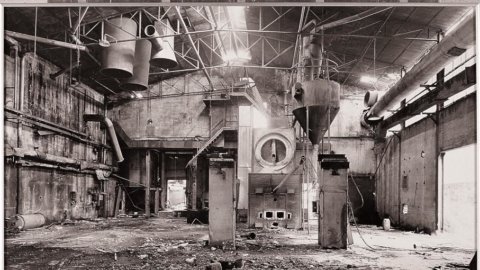The Civic Gallery of Modena opens the exhibition "Gabriele Basilico in the collection of the Civic Gallery of Modena" on Saturday 23 November at 17.30 pm. Curated by Silvia Ferrari, promoted and organized by the Civic Gallery of Modena and the Cassa di Risparmio di Modena Foundation with the support of the Culture Department of the Emilia-Romagna Region, the exhibition is organized in collaboration with Giovanna Calvenzi.
Commissioned by the monthly "Modo" in 1978 to carry out a photographic survey on the world of discos in Emilia Romagna, and more fully on the phenomenon of Emilian dance halls, Basilico made a reportage of what was later called the Italian Nashville exploring three hundred kilometers of dancing, from Reggio Emilia to the Ca' del Liscio in Ravenna, obtaining a fresco on mass entertainment that portrays "exuberant and original places but with a somewhat local, all-Italian atmosphere". Among the places visited were the Club 501 of Gualtieri, the Marabou of Sant'Ilario d'Enza, the Picchio Rosso of Formigine. From this series that was exhibited in Modena for the first time in 1980 - probably among the lesser known ones, a significant trace of his first approach to photography, more attentive to the social and committed gaze - a selection of about twenty images is presented today.
The exhibition also retraces the presence in Modena of Gabriele Basilico, protagonist of three historic campaigns of photographic documentation: "The eyes on the city", which he conducted together with Olivo Barbieri and Mimmo Jodice in 1994 on behalf of the Municipality of Modena, "LR 19/ 98. The redevelopment of urban areas in Emilia-Romagna" of 2001, promoted by the Emilia-Romagna Region and by the IBC, Cultural Heritage Institute of the Emilia-Romagna Region, which documented the abandoned areas, almost always on the edge of the historic city, former steel mills , former foundries, former livestock market, former pomace – exemplary recognition of urban transformations – and finally that of 2011, resulting from the agreement between the Municipality of Modena and the IBC, as part (essay in images) of the volume “Cities and architecture. The twentieth century in Modena” (Franco Cosimo Panini editore, Modena 2013), edited by the Research and Documentation Office on Urban History of the Municipality of Modena in collaboration with the Cassa di Risparmio di Modena Foundation, as a tool, aimed at citizens, for reading and understanding of the relationship between architecture and urban space in the last century.
25 photographs of this last survey on the territory will be presented, today exhibited for the first time.
The project is then enriched thanks to the collaboration of the Photography Foundation, which lent five large-format works, urban views of European cities (Bilbao, Porto, Genoa, Milan, Dieppe), created between the 80s and 90s, particularly significant of the photographer's style, and of the IBC of Bologna which integrated the nucleus dedicated to the urban areas of Emilia Romagna.
The screening of the documentary film "Gabriele Basilico", part of the "Italian Photography" series, made in 2009 by the video production house Giart, in collaboration with Contrasto, under the patronage of the Cineteca di Bologna, deepens the figure of the author. The “Dancing in Emilia” series is once again the protagonist of a volume with texts by Silvia Ferrari, Gustavo Pietropolli Charmet and with a 2007 conversation between Gabriele Basilico, Massimo Vitali and Giovanna Calvenzi.
The new book is published, more than thirty years after the first edition, by the Civic Gallery of Modena and by Silvana Editoriale.
Gabriel Basil was born in Milan in 1944. After graduating in architecture (1973), he devoted himself continuously to photography. The shape and identity of cities, the development of the metropolis, the changes taking place in the post-industrial landscape have always been his privileged areas of research. Considered one of the masters of contemporary photography, he has been awarded many prizes and his works are part of important Italian and international public and private collections.
"Milan portraits of factories" (1978-80), is the first long work that has the industrial periphery as its subject and corresponds to his first exhibition presented in a museum (1983, Padiglione Arte Contemporanea, Milan).
In 1984-85, with the "Bord de mer" project, he was the only Italian to participate in the Mission Photographique de la DATAR, the great government assignment entrusted to an international group of photographers with the aim of documenting the transformations of the French landscape.
In 1991, with other international photographers, he took part in a mission to Beirut, a city devastated by a 15-year civil war. Since then Gabriele Basilico has produced and participated in numerous documentation projects in Italy and abroad, which have generated exhibitions and books, including "Porti di mare" (1990), "L' EXPERIENCE OF PLACES" (1994), “Italy, cross sections of a country” (1998), “Interrupted City” (1999), “Cityscapes” (1999), “Berlino” (2000), “Scattered City (2005), “Appunti di viaggio” (2006) , “Intercity” (2007).
Among the most recent works, “Roma 2007”, “Silicon Valley '07” (on behalf of the San Francisco Museum of Modern Art), “Vertical Moscow”, an investigation into the urban landscape of Moscow, taken in 2010 from the top of the seven Staliniane”, “Istanbul 05.010”, Shanghai 2010, Beirut 2011, Rio 2011, “Reading the photographs” (2012). Participates in the XIII International Architecture Exhibition of the Venice Biennale (2012) with the project "Common Pavilions", designed by Adele Re Rebaudengo and created in collaboration with Diener & Diener Architekten, Basel.
Gabriele Basilico died in Milan on February 13, 2013.
It is noted moreover that from 27 November 2013 to 30 March 2014 at the MAXXI, National Museum of XXI Century Arts in Rome, the exhibition “Gabriele Basilico. Photographs from the MAXXI collections” curated by Giovanna Calvenzi and Francesca Fabiani. Over 70 photographs from the museum's collections to tell the long and happy collaboration with one of the greatest interpreters of architectural photography in Italy, a master of suggestions, reflections and artistic visions. (http://www.fondazionemaxxi.it)





